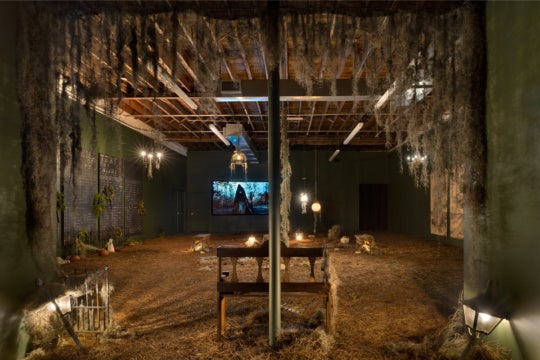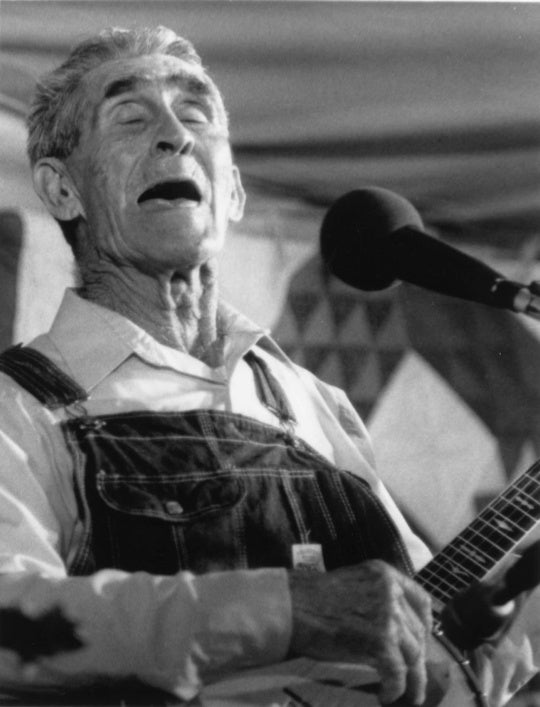
Sarah Hobbs’s Overpacked, which was at the W Atlanta-Midtown hotel from December 16 through December 19, is a transition for the artist from photography into installation art. In her photographs, Hobbs constructs tableaus of neuroses that exist as sets for her images. For the W Hotel installation, the artist staged three hotel rooms as sites of anxiety, with an open invitation for visitors to trespass and interpret the clues she placed.

An idea two years in the making, the installation was facilitated by curator Nancy Solomon and PR maven Liz Lapidus, who represents W Atlanta-Midtown. Each room was meant to encompass a different compulsion, neurosis, or desire. Unlike her photographs, the rooms were untitled, leaving the viewer to ascertain each theme.
Room 503 was closest to the elevator, sequentially the first layer of this Russian doll experience. A path from the door to the bedroom was laid out in unbroken glow sticks, while strips of reflective tape speckled the bathroom floor. An insulated tent was set up on the floor at the foot of the bed; antianxiety meds, emergency ponchos, a crowbar, helmet, and other disaster supplies were on display as if arranged by the imagined occupant. A copy of The Complete Worst-case Scenario Survival Handbook rested on the bedside table; a disc of the same title rested atop the DVD player. The text seemed to spell out Hobbs’s intention: to represent someone who worries about the worst-case scenario, even in a hotel room—or was it a person hiding out in a hotel to escape a crisis? Despite the plethora of props, the elements in this room seemed at odds with the room and each other. The tent seemed redundant next to the room’s queen-size bed with comforter, as did the double copies The Worst-case Scenario. The room left many questions unanswered, creating confusion rather than intrigue, and the abundance of items obscured any clear narrative.


The move from photography to installation is a transition from one vista to a plurality of vistas available to the viewer. Rather than the flat plane of a photograph, an installation creates an immersive experience with varying degrees of interactivity. These realities required Hobbs to deviate from the multiplicity of one prop which marks her photographs (see Jackson Fine Art’s artist page for examples) to a variety of different items. Though this necessity to use many different items led to incoherence in room 503, other rooms, like 510, were much more successful.
Room 510 offered a more detailed and consistent portrayal of an individual. The bed, though made, was rumpled and topped with plaid pillows and a throw that the imagined occupant must have brought from home. Well-worn slippers rested on the floor next to the bed, and running shoes and crumpled socks lay, seemingly discarded, in a corner. A model of a house and a snow globe featuring a picture of the same house were placed on a glass shelf. Strikingly, the hotel room windows had been covered with a screen that featured a view of a residential lawn, the neighbor’s house visible through trees. This presumably was the view from the interior of the house in the snow globe. The view-screen, truly a strange thing to imagine someone traveling with, seemed natural in this setting: the room of someone creating a home away from home. There were also hidden details, some of which reinforced this theme, others seeming incomplete. A dried daffodil rested within a box on a shelf, creating a tender yet unknowable clue. A book on the bedside table seemed unread, and the notepad bookmarking a page was unmarked—details inconsistent with other items like the worn slippers.



The level of allowed participation was unclear going into the installation; most viewers, well-trained to behave in galleries, stuck to the walkways and kept their hands by their sides. It required a bit of boldness to begin interacting with the elements, to open the box with the dried flower, or flip the book pages to see the bookmark. The unease created by not knowing what viewers were or were not supposed to do added an element of trespass to the work, heightening the believability and thus the immersion of the experience.
Elements of the hotel naturally incorporated themselves into the experience of the installation. In the hallway, one could hear the voices of hotel guests muffled through closed doors; housekeeping was working on rooms at the other end of the hall. These details became activated parts of the installation, adding to the sense that we were trespassers in these hotel rooms whose occupants might at any moment return.
If room 510 was the most personal and empathetic, room 514 was the most immersive. The final stage of the experience, 514 provided the most sensory stimulation. Plastic mats lined every floor, creating a strange surface to walk on and an overwhelming smell. Shower caps were wrapped around every item, from remote controls to toilet handle, and disinfectant spray bottles, lint rollers, and latex gloves were carefully placed throughout for easy accessibility. If a germphobe must stay in a hotel room, a space with a multitude of occupants, this is how he or she copes. A young boy who entered prior to me exclaimed, “You have to take off your shoes in this one!” and proceeded to do so before stepping in. His innocent remark recalls an anecdote from Robert Irwin’s 1970 project at New York MoMA: Fractured Light – Partial Scrim – Ceiling – Eye-Level Wire, which Claire Bishop cites in her book Installation Art (a description is available in this essay).
…a fifteen-year-old boy entered the work, said ‘wow’ and ‘spun around, sort of walked around in a revolving circle, turning as he went, just sort of really reaching and responding to it’. ‘Such a spontaneous response was, for Irwin, evidence of the primacy of embodied perception over intellection. As such, he considered his work to be democratically available to everyone. (Bishop, 57)
Bishop writes that for Irwin, this demonstrated that interpretative criticism, like photographic documentation, was of limited value in relation to the work. He placed primary importance on the first-hand experience, tying it to Maurice Merleau-Ponty’s ideas of perceptual experience.
Hobbs’s installations don’t interact with the same perceptual concerns as Irwin’s but rather attempt to enact an exploration and expansion of her own work. Hobbs is attempting to transcend the flat photographic plane of her prior work through installation, to varying degrees of success. Not every room was able to transcend the plane of picture into the realm of believability. In the more successful rooms, however, viewers could imagine the occupant by pulling from personal experience and knowledge. In these moments in Overpacked, Hobbs is able to tap into an aspect of installation that separates it from photography; the potential psychological effects of the experience on and within the viewer.




